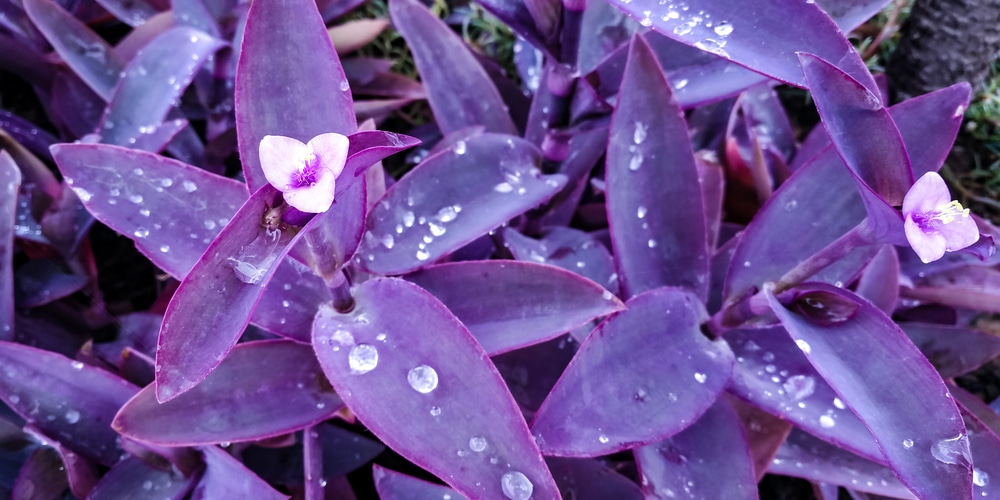If you have an evergreen flower garden or are planning to start a colorful garden but do not know which plants to begin with, don’t hesitate to try the tradescantia pallida plants.
The tradescantia pallida (purple heart) plants are fast-growing evergreen plants with a vibrant purple hue on the stems and leaves. It magically adds lasting beauty to your garden with the foliage and later appreciates nature and effort by producing small deep pink or purple flowers.

| Botanical Name | Tradescantia pallida |
| Common Name | Purple queen, purple heart, purple secretia |
| Plant Type | Perennial or annual in some regions |
| Flower Color | Small pink or purple 3 petaled flowers |
| Size When Mature | 8 inches tall and 18 inches wide |
| Bloom Time | Mid summer to fall |
| Sun Requirements | Full/ Partial Sun |
| USDA Hardiness Zones | USDA zone 8-11 |
| Soil PH Range | 6-8 |
| Soil Type | Acidic or alkaline well-draining lightweight soil |
| Water Needs | Medium |
| Native Area | Mexico |
Of significance, even though tradescantia pallida plants are easy to grow, they need specific care and growing conditions to thrive. This post covers all the fast facts about the plants and how to care for them.
What you need to know about Tradescantia pallida
Tradescantia pallida, commonly known as purple queen, purple heart, or purple secretia, is a tender evergreen perennial native to Mexico. It belongs to the spiderwort family.
While it is a fast-growing perennial, it can be grown as an annual in some regions. No matter where or how it is grown, it ornaments with its striking purple lance-shaped leaves that can grow up to 7 inches long. The leaves are produced alternately on the plant’s fragile purple stems. The entire plant grows to about 8 inches, and its branches spread about 18 inches wide.
These purple heart plants bloom from mid-summer to fall, producing about ½ inches wide 3-petaled purple or deep pink flowers with striking long yellow stamens. These beautiful blooms stay open in the morning and close up when temperatures start to rise.
Typically, the tradescantia pallida is a versatile plant grown as a groundcover to add a beautiful center point of attraction to a landscape or create a trailing garden border. The plants can also be grown as houseplants on the patio or hung in a basket attached to the house indoors and outdoors.
Despite being attractive to the eyes, this beauty should just remain to be admirable to the eyes and not by touch with bare hands. This is because tradescantia pallida are toxic to humans and pets and can cause contact dermatitis.
How to care for tradescantia pallida
Here is everything you need to know about growing and caring for thriving tradescantia pallida.
Light
Tradescantia pallida plants grow well in shade areas with enough bright light. They can also grow in areas with full sunlight, but the leaves will be more green than purple, therefore, losing their beauty. It is also important to note that too much shade can make the plants leggy.
Water and soil need
The tradescantia pallida plants are drought tolerant and may not require frequent watering. When it comes to watering, wait until the top few inches of the soil dries up between waterings to help the deep roots strengthen. However, during heat waves or extensive sunlight, check your soil frequently because you may need to water more often.
Normally, tradescantia pallida plants grow well in light, moist, well-draining porous soil. Alkaline or acidic soil with a pH ranging from 6-8 is suitable for growing tradescantia pallida plants.
Temperature requirements
The purple queen(tradescantia pallida) cannot tolerate freezing conditions. As such, they should only be grown outdoors in regions with a mild climate. For gardeners living in regions with extreme climates, grow tradescantia pallida indoors and serve them with adequate warmth and light.
Tradescantia pallida plants are hardy for USDA zones 8 to 11, where they are mostly planted in outside gardens. They thrive best when temperatures range from 60 to 80 degrees Fahrenheit but may ensure temperature drops to 40°.
Fertilizer
Tradescantia pallida are not heavy feeders, but they will appreciate a well-balanced liquid fertilizer, especially if your pot soil has a poor nutrient profile. Dilute the fertilizer to half the regular strength for more effective results.
Common diseases
There is no known common disease that affects these plants. However, they can suffer root rot when supplied with too much water.
Propagation
You can easily propagate purple heart plants using healthy stem cuttings with at least one node. Remove the lower leaves and dip the stem in a rooting hormone or water before planting them in new well-prepared soil.

